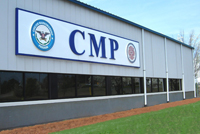ANNISTON, ALABAMA - If you're a first-time visitor to northeast Alabama, two things you'll notice about this foothills region of the Appalachian Mountains is the smell of pine, its friendly people and the abundance of rich red clay.
Red clay, in fact, is so prevalent; it has given rise to several Alabama nicknames - the most famous of which is the Crimson Tide of the University of Alabama athletics program.
That moniker was bestowed on the 1907 Alabama football team by a Birmingham sports reporter who witnessed a 6-6 tie played on a rain-soaked field against rival Auburn University. Over the course of the game, the mud turned the Alabama jerseys red and the reporter said the team appeared to roll down the field "like a crimson tide."
One thing you don't readily notice in Anniston is the Civilian Marksmanship Program's operation which employs 65 staff members that provide internal service to the entire organization and externally to thousands of CMP customers and program participants nationwide. In floor space, CMP's Anniston facilities occupy more than 300,000 square feet under roof in four buildings in an industrial park on the city's southeast side.

|
The city of Anniston is also a neighbor to the Anniston Army Depot (ANAD), which plays a pivotal role in CMP South's mission of making decommissioned military rifles and parts available for purchase by qualified US citizens for training and competitive purposes. The rifle program is a very small part of ANAD's primary role as America's combat vehicle support center where it refurbishes and refits armored US Army equipment but its relationship with the US Army and ANAD is critical to the success of its programs. For more info, log onto http://www.anad.army.mil/anadDefault.shtml.
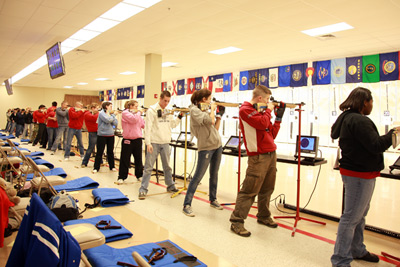
|
From humble beginnings as the firearms sales arm of CMP with nothing more than a picnic table and a 10,000 square-foot warehouse run by one employee, CMP South has grown dramatically in size and scope since CMP was privatized in 1996. In addition to its rifle program servicing and warehouse facilities, CMP South is now home to the organization's second world-class airgun marksmanship center - a twin of the computer-controlled, electronically-scored indoor range at CMP North at Camp Perry.
CMP South provides management, financial controls, payroll services and generates sales revenue as well. It's the point of entry for all firearms, ammunition and accessories made for sale through the CMP's stores and Web sales programs.
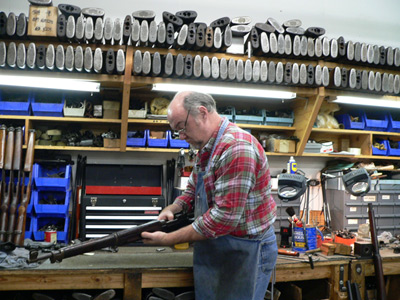
|
What the CMP South location is better known for, at least internally, is its role in acquiring, organizing, grading, restoring, warehousing and sale of surplus rifles such as the M1 Garand, M1 Carbine, 1903 and 1903A3 Springfield and more.
CMP North, with 22 employees, is situated at Camp Perry, an Ohio Army National Guard (OHNG) training site just west of Port Clinton, located on the southern shore of Lake Erie. It's home to the organization's programs headquarters, north store and indoor marksmanship center. Its staff directs the organization's marksmanship, safety and instructional programs which serve thousands of citizens nationwide each year.
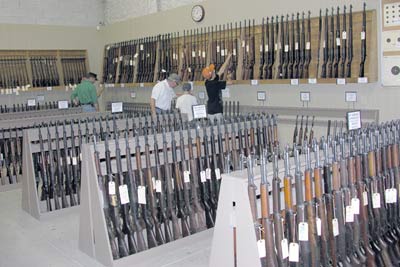
|
Camp Perry's outdoor range, owned by OHNG and leased by CMP is home to the National Rifle and Pistol Championships (National Trophy Matches) and CMP Games Events each July and August.
To fully appreciate the relationship between the CMP's Alabama and Ohio cousins and how they've grown, it's helpful to understand how the organization evolved.
Today's CMP is a private, 501(c)(3) non-profit descendent of a government-chartered body borne from the 1903 War Department Appropriations Act - a federal law enacted by US Congress that provided citizens a means to learn and practice marksmanship skills.
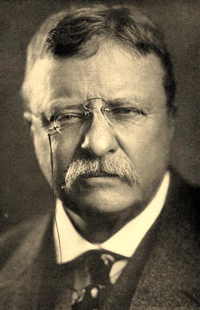
|
The original organization, administered by the US Army, was an early homeland security readiness effort fervently supported by President Theodore Roosevelt during the decade following the Spanish-American War. It was originally called the National Board for the Promotion of Rifle Practice (NBPRP).
In 1906 Roosevelt said "Congress has most wisely provided for a national board for the promotion of rifle practice. Excellent results have already come from this law, but it does not go far enough.
“Our Regular Army is so small that in any great war we would have to trust mainly volunteers, and in such event these volunteers should already know how to shoot."
Essentially, the NBPRP was charged with a half-dozen primary functions - to instruct qualified US citizens in marksmanship; to promote practice and safe use of firearms; to conduct competitions and award competitors for their achievements; to secure and account for firearms, ammunition and equipment; to issue, loan, or sell firearms, ammunition and repair parts for the purpose of marksmanship practice and to procure the necessary supplies and services to carry out its programs.
In 1996, in order to shift the operational focus from the Army to civilian administration, the NBPRP (commonly known then as office of the Director of Civilian Marksmanship or DCM) was replaced by the Corporation for the Promotion of Rifle Practice and Firearms Safety, Inc. (also know as CMP).
This shift to a private entity also applied greater focus on youth participation and development. The newly-created organization was governed by a board of directors appointed by the Secretary of the Army. Today, that 12-member board, chaired by Charles Maddox, develops and implements all CMP policies.
Each of the original functions remains intact today and CMP relies upon both north and south centers to carry out its mission. The military steadfastly plays a vital role in CMP programs in a logistics support and training role.
Through its relationships with all branches of the US military, state & local shooting associations, law enforcement and youth organizations, CMP reaches out to thousands of citizens each year through training programs and marksmanship competitions.
NEXT ARTICLE
|
